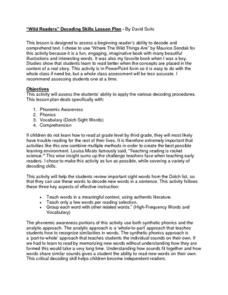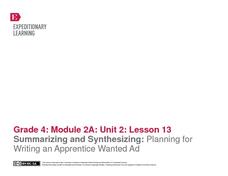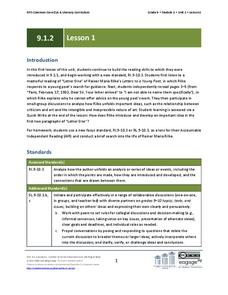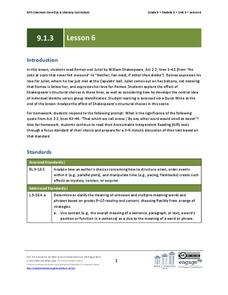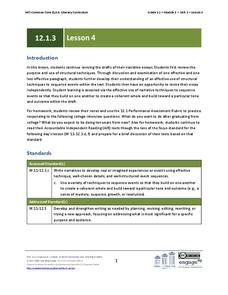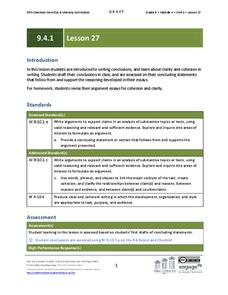Lakeshorelearning
Read and Write about It
Reading informational text is a skill that transcends subjects and grade levels. Practice reading about different topics in various formats with a language arts lesson that includes opportunities for writing and research as well.
Curated OER
George Winter Lesson Plan 3
Bring language arts and U.S. history together in this lesson, which prompts middle and high schoolers to gather biographical information about Abraham Lincoln. They compare and contrast information written about his childhood and discuss...
Curated OER
Rudyard Kipling's Rikki-Tikki-Tavi: Mixing Words and Pictures
Create meaningful illustrations to accompany stories in a web-based art and literacy lesson focused on "Rikki-Tikki-Tavi" by Rudyard Kipling. The class takes a virtual art safari with the Museum of Modern Art and then discusses how...
Curated OER
What A Pair! A Cross Grade Writing Activity
What a pair! Older pupils interview younger ones and use what they learn to write a short, illustrated storybook that features the youngster as the main character. The youngster responds with a thank-you note in which they identify their...
Curated OER
Toot & Puddle: Puddle's ABC Lesson Plan
Students familiarize themselves with the sounds of the alphabet by creating an alphabet book. In this early childhood language arts lesson, students identify uppercase and lowercase letters, recognize sounds, and review the order of the...
EngageNY
Introducing Research Folders and Generating a Research Question
Take the next step in the writing process with a lesson plan geared towards the completion of writing an evidence-based essay about a rule to live by, as Bud did in Bud, Not Buddy by Christopher Paul Curtis. Pupils collaborate with their...
Star Wars in the Classroom
"Shakespeare and Star Wars": Lesson Plan Day 4
Class members have an opportunity to compare how a film and a play handle the same source material by viewing the opening chapters of George Lucas's Star Wars: A New Hope and acts I and II of Ian Doescher's play, William...
David Suits
“Wild Readers” Decoding Skills Lesson Plan
Set young readers on the path toward fluency with this phonemic awareness resource. Based on the award-winning children's book, Where the Wild Things Are, this lesson allows beginning readers to practice isolating...
Curated OER
Lesson Plan for Scaffolding Complex Texts
Enhance a class read-aloud of the children's story Hi! Fly Guy with this reading comprehension lesson. Children first listen as the teacher reads the story, stopping along the way to discuss any unfamiliar vocabulary. The book...
EngageNY
Summarizing and Synthesizing: Planning for Writing an Apprentice Wanted Ad
In instructional activity 13 of this unit on colonial trade, young researchers learn about apprentices as they prepare to write help-wanted ads for the specific trade they have been researching. To begin, the class listens closely as the...
Curated OER
English Lesson Plans for Grade 8
Demonstrate how to engage in a polite and professional conversation with this banking and interfacing instructional activity. Focusing on explanatory and informaitonal texts, middle schoolers write sentences using banking and finance...
Premier Literacy
Point of View
Incorporate technology into a literature lesson with an innovative language arts lesson. Middle schoolers read an electronic version of original stories or fairy tales, and after determining the point of view, rewrite the tale from...
Curated OER
English Lesson Plans for Grade 7
Discuss the correct use of certain phrases such as "managed" and "could" in this English lesson. Middle schoolers listen to interviews on work customs in different countries and compare them. They make inferences after reading given...
EngageNY
Grade 9 ELA Module 1, Unit 2, Lesson 1
Where does a writer find inspiration? "Go into yourself," says Rainer Maria Rilke in "Letter One" from Letters to a Young Poet. Readers of Rilke's letter to Franz Xaver Kappus examine the words and figurative language Rilke uses to...
EngageNY
Grade 9 ELA Module 1: Unit 3, Lesson 6
The balcony scene from Romeo and Juliet takes center stage as class members consider the structural choices Shakespeare makes, i.e., having Romeo appear first in the scene and having Juliet appear unaware that Romeo is listening to her...
EngageNY
Grade 12 ELA Module 1, Unit 2, Lesson 4
The fourth instructional activity in this narrative writing unit focuses on how Leslie Marmon Silko uses telling details and sensory language in her "Yellow Woman and a Beauty of the Spirit" to bring alive the people of Laguna Pueblo and...
EngageNY
Grade 9 ELA Module 1: Unit 3, Lesson 11
The study of Romeo and Juliet continues as pairs use the provided summary tool worksheet to record evidence of how Shakespeare uses dramatic irony to heighten the tension in Juliet's soliloquy in Act 3, scene 2, lines 1–31.
EngageNY
Grade 9 ELA Module 3, Unit 2, Lesson 10
Ninth graders continue their inquiry-based research projects focused on the topics in Temple Grandin's Animals in Translation. After formulating, honing, and adapting their research frames in the previous lessons, learners select...
EngageNY
Grade 11 ELA Module 1: Unit 2, Lesson 16
Using the resource, scholars read Act 3.3 of Shakespeare's Hamlet. They analyze two soliloquies and discuss how Shakespeare develops the characters.
EngageNY
Planning the Introductory and Concluding Paragraphs of the End of Unit Assessment Essay
Preparation is the key to success! Using the guiding resource, scholars plan their end-of-unit analytical essays' introductory and concluding paragraphs based on their reading of Inside Out & Back Again. To prepare, they complete a...
EngageNY
Grade 12 ELA Module 1, Unit 3, Lesson 4
Once again, class groups examine two model paragraphs and, using the provided rubric, evaluate how effectively the writers use structural techniques to sequence events so that they build a specific tone. Individuals then use what they...
Curated OER
Lesson Plan for The Little Red Hen
Cultivate young performers while teaching them about helping one another with this interactive storytelling lesson. Elementary schoolers read or listen to the story The Little Red Hen by Mike Lockett and then act out the story while...
EngageNY
Planning for Writing: Introduction and Conclusion of a Literary Argument Essay
After completing three body paragraphs of an argument essay about life's rules to live by from Bud, Not Buddy Christopher Paul Curtis, it's time to begin writing the introduction and conclusion. Independently, pupils draft the final two...
EngageNY
Grade 9 ELA Module 4, Unit 1, Lesson 27
Crafting a clear and cohesive conclusion to any piece of writing is crucial. An effective conclusion restates the central claim in the introduction, briefly summarizes the supporting claims, and presents a new way of thinking about the...







